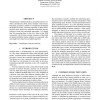ISMIR
2005
Springer
14 years 6 months ago
2005
Springer
The singing voice is the oldest and most complex musical instrument. A familiar singer’s voice is easily recognizable for humans, even when hearing a song for the first time. O...
ISMIR
2005
Springer
14 years 6 months ago
2005
Springer
A pitch spelling algorithm predicts the pitch names of the notes in a musical passage when given the onset-time, MIDI note number and possibly the duration and voice of each note....
ISMIR
2005
Springer
14 years 6 months ago
2005
Springer
The use of HMM (Hidden Markov Models) for speech recognition has been successful for various applications in the past decades. However, the use of continuous HMM (CHMM) for melody...
ISMIR
2005
Springer
14 years 6 months ago
2005
Springer
In music genre classification the decision time is typically of the order of several seconds, however, most automatic music genre classification systems focus on short time feat...
ISMIR
2005
Springer
14 years 6 months ago
2005
Springer
Though music is fundamentally an aural phenomenon, we often communicate about music through visual means. The paper examines a number of visualization techniques developed for mus...
ISMIR
2005
Springer
14 years 6 months ago
2005
Springer
In this paper we present a system for the automatic mining of information from music reviews. We demonstrate a system which has the ability to automatically classify reviews accor...
ISMIR
2005
Springer
14 years 6 months ago
2005
Springer
This paper presents ACE (Autonomous Classification Engine), a framework for using and optimizing classifiers. Given a set of feature vectors, ACE experiments with a variety of cla...
ISMIR
2005
Springer
14 years 6 months ago
2005
Springer
Recently, several music information retrieval (MIR) systems have been developed which retrieve musical pieces by the user’s singing voice. All of these systems use only the melo...
ISMIR
2005
Springer
14 years 6 months ago
2005
Springer
We present a freely available benchmark dataset for audio classification and clustering. This dataset consists of 10 seconds samples of 1886 songs obtained from the Garageband si...
ISMIR
2005
Springer
14 years 6 months ago
2005
Springer
A personal digital music library needs to be “agile”, that is, it needs to make it easy to capture and index material on the fly. A digital camera is a particularly effective...



